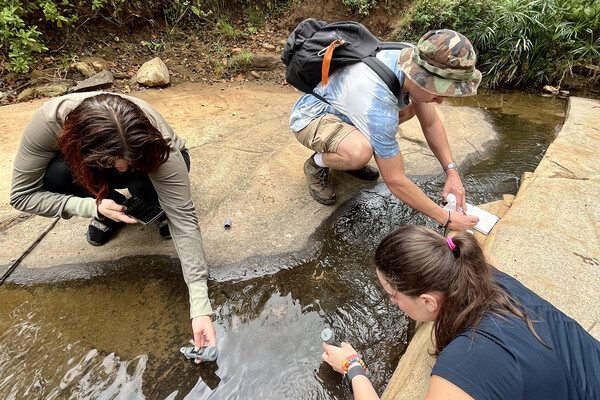
Griffin Pitt, right, works with two other student researchers to test the conductivity, total dissolved solids, salinity, and temperature of water below a sand dam in Kenya.
(Image: Courtesy of Griffin Pitt)
 Candace diCarlo
Candace diCarlo Of all the body’s systems, the one involved with smelling—the olfactory system—may be among the least studied. Penn neuroscientist Minghong Ma says she can understand why, but that hasn’t stopped her researching it—and making some important discoveries about how we smell.
“Traditionally this is a really small field compared to the visual system,” she says, “because the inability to smell is not as devastating as not being able to see things. On the other hand, for basic neuroscience all the sensory systems have a similar design—starting with a specialized sensory organ and then sending the information to the brain and the brain trying to decipher what’s coming into it—so in that sense the olfactory system is just as important as any other system.”
Ma, a Penn Medicine assistant professor of neuroscience, has been studying olfactory nerve cells for several years now, and recently she and her lab came upon an interesting discovery: our sense of smell works double duty, detecting both chemical and mechanical stimuli. In other words, we smell better when we sniff.
Initially, explains Ma, whose research was published in the March 2007 issue of Nature Neuroscience, she was interested in how odor molecules were encoded in the nose. The researchers tested two different types of stimulation on olfactory neurons in mice: chemical stimuli such as those used in making perfumes, and mechanical stimuli, or pressure carried by airflow to the nostrils while breathing.
Ma’s team discovered that many cells respond not only to odor stimuli but also to pure mechanical pressure. “It was actually sort of annoying for a while,” she says, “because it meant we had to do a lot more controls for each experiment.”
The discovery was important, though, because it helps to explain why we sniff to smell something and why our sense of smell is synchronized with inhaling. That synchronization has been known about for more than 50 years, though the reason behind it has remained a mystery.
One explanation, says Ma, is that this mechanical sensitivity can help when an odor stimulus is weak. “We provided evidence at the single cell level by delivering odor at the same concentration but different levels. If you give higher pressure, you’re mimicking a really powerful sniff instead of normal breath. If you do that, the same odor delivered at higher pressure will cause a higher response in single cells. We think this might explain how the sniff works. Sniffing pulls more air into the nose so potentially it can concentrate the odor concentration that will come in contact with the olfactory sensory neurons.”
Another possibility is that the olfactory system is capable of sending both airflow information and odor responses together to the olfactory bulb in the brain, which then figures out an odor’s quality and intensity. “You can probably think of a scenario,” says Ma, “where if there’s a strong odor outside you take shallow breaths and another scenario where you have a really weak odor but you sniff it in a powerful way. That would probably generate the same amount of activity in the bulb since you get the same amount of the odor into your system. The brain will tell these two scenarios apart. It just needs the airflow information.”
Ma stresses that her research is not proof of how the system works, just strong evidence. Now, she says, more work needs to be done to find out what exactly is sensing the air pressure—whether there is a pressure sensor in the nose or if the odor receptors themselves have mechanical sensitivity.
One thing is clear, Ma intends to keep studying the nose to learn more about how we sniff and smell. After all, she says, “It really affects our life quality. I can’t imagine if you couldn’t taste wine or smell flowers. You know, life would be so boring, right?”

Griffin Pitt, right, works with two other student researchers to test the conductivity, total dissolved solids, salinity, and temperature of water below a sand dam in Kenya.
(Image: Courtesy of Griffin Pitt)

Image: Andriy Onufriyenko via Getty Images

nocred

Provost John L. Jackson Jr.
nocred